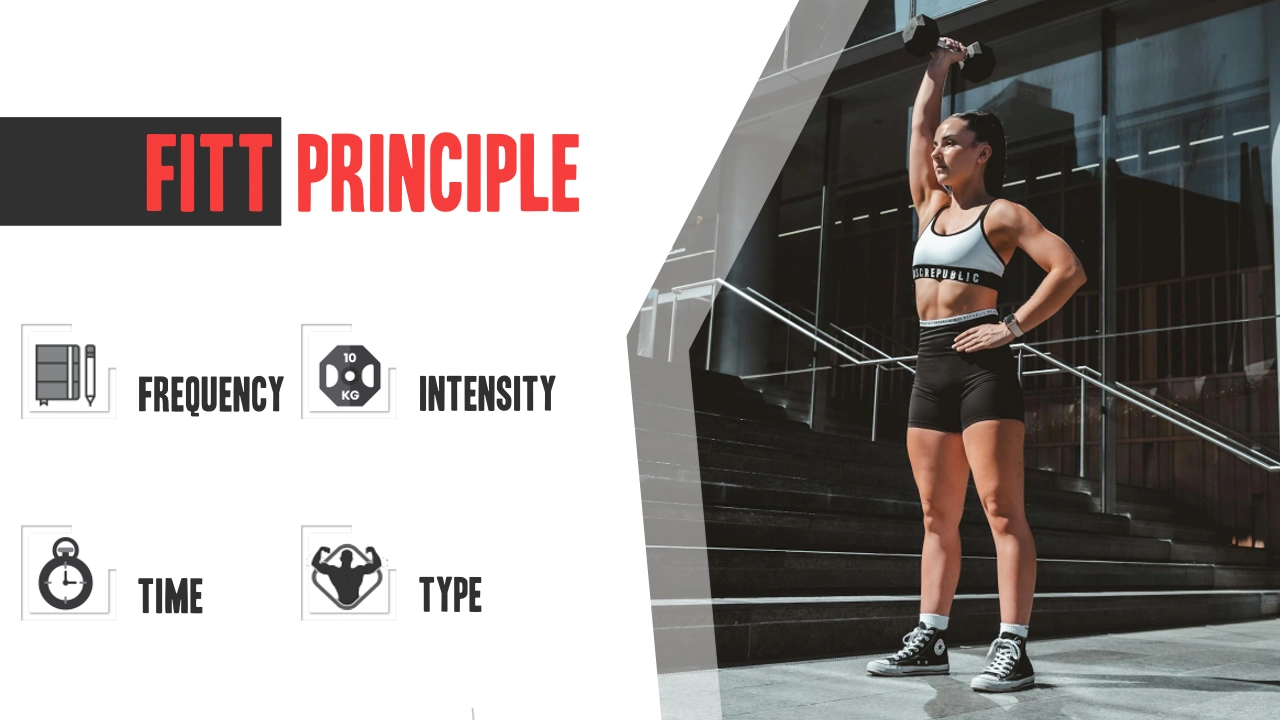Contents
Creating an effective workout plan requires more than simply choosing a few exercises. Many beginners and even experienced lifters often struggle with structuring their training in a way that leads to steady progress. To solve this challenge, exercise scientists and coaches use the FITT principle—a simple yet comprehensive guideline that helps individuals organize their workouts. By focusing on Frequency, Intensity, Time, and Type, this principle ensures that fitness training is balanced, adaptable, and tailored to personal goals.
What is the FITT Principle?
The FITT principle is a framework used in exercise science to design well-rounded training programs. Each letter stands for a key training variable:
- Frequency – How often you exercise
- Intensity – How hard you exercise
- Time – How long each session lasts
- Type – What kind of exercise you perform
When these four elements are adjusted correctly, they form the foundation of progressive overload, long-term fitness improvements, and reduced risk of overtraining.
Frequency: How Often to Train
Frequency refers to the number of training sessions per week. The ideal frequency varies depending on fitness level, training goals, and recovery ability.
- Beginners may start with 2–3 sessions per week.
- Intermediate to advanced athletes may train 4–6 times per week, often splitting workouts into muscle groups or training modalities.
- For endurance sports, frequency may also include multiple daily sessions.
Intensity: How Hard to Train
Intensity describes the effort level of a workout. It can be measured in different ways depending on the type of exercise:
- Resistance training: percentage of one-rep max (1RM), number of repetitions, or perceived exertion.
- Cardio training: heart rate zones, VO₂ max percentage, or pace.
- General fitness: use of the Rate of Perceived Exertion (RPE) scale, ranging from 1 (very light) to 10 (maximum effort).
Balancing intensity is critical: training too light may not stimulate adaptation, while training too hard may lead to fatigue or injury.
Time: Duration of Each Workout
Time refers to the length of each training session or the total accumulated exercise time.
- For general health, organizations like the World Health Organization (WHO) recommend 150 minutes of moderate-intensity or 75 minutes of vigorous-intensity activity per week.
- Strength training sessions may last 30–90 minutes, depending on volume and rest intervals.
- Endurance training can range from 20 minutes to several hours, depending on the sport.
Type: Choosing the Right Exercise
The type of training depends on the goal:
- Cardiovascular health: running, cycling, swimming, rowing.
- Strength and muscle growth: weightlifting, bodyweight training, resistance bands.
- Flexibility and mobility: yoga, Pilates, dynamic stretching.
- Sports performance: sport-specific drills combined with strength and conditioning.
Selecting the right type of activity ensures that workouts match the desired outcome.
Benefits of the FITT Principle
Using the FITT principle provides a structured path to progress while preventing plateaus. Key benefits include:
- Adaptability for beginners and advanced athletes
- Balanced approach to avoid overtraining
- Ability to target specific goals (fat loss, muscle gain, endurance, health)
- Long-term sustainability through gradual progression
Practical Example of the FITT Principle
To see how the FITT principle works in practice, here is an example for a general fitness goal:
- Frequency: 4 sessions per week
- Intensity: Moderate intensity (65–75% HRmax or RPE 6–7)
- Time: 45 minutes per session
- Type: 2 strength training sessions, 2 cardio sessions
For a muscle-building program:
- Frequency: 5 sessions per week (upper/lower split)
- Intensity: 65–85% of 1RM in resistance training
- Time: 60–75 minutes per session
- Type: Compound lifts, accessory work, hypertrophy-focused exercises
Conclusion
The FITT principle remains one of the most practical and widely used tools in exercise programming. By manipulating frequency, intensity, time, and type, anyone can design workouts that align with their fitness goals—whether that’s improving health, building strength, or excelling in sports performance. Instead of relying on guesswork, the FITT principle provides a structured yet flexible path to long-term results.
References
- American College of Sports Medicine. ACSM’s Guidelines for Exercise Testing and Prescription. 11th Edition. Wolters Kluwer, 2021.
- World Health Organization. Physical Activity Guidelines. 2020.
- Garber CE, et al. Quantity and Quality of Exercise for Developing and Maintaining Cardiorespiratory, Musculoskeletal, and Neuromotor Fitness in Apparently Healthy Adults: ACSM Position Stand. Med Sci Sports Exerc. 2011;43(7):1334–1359.



